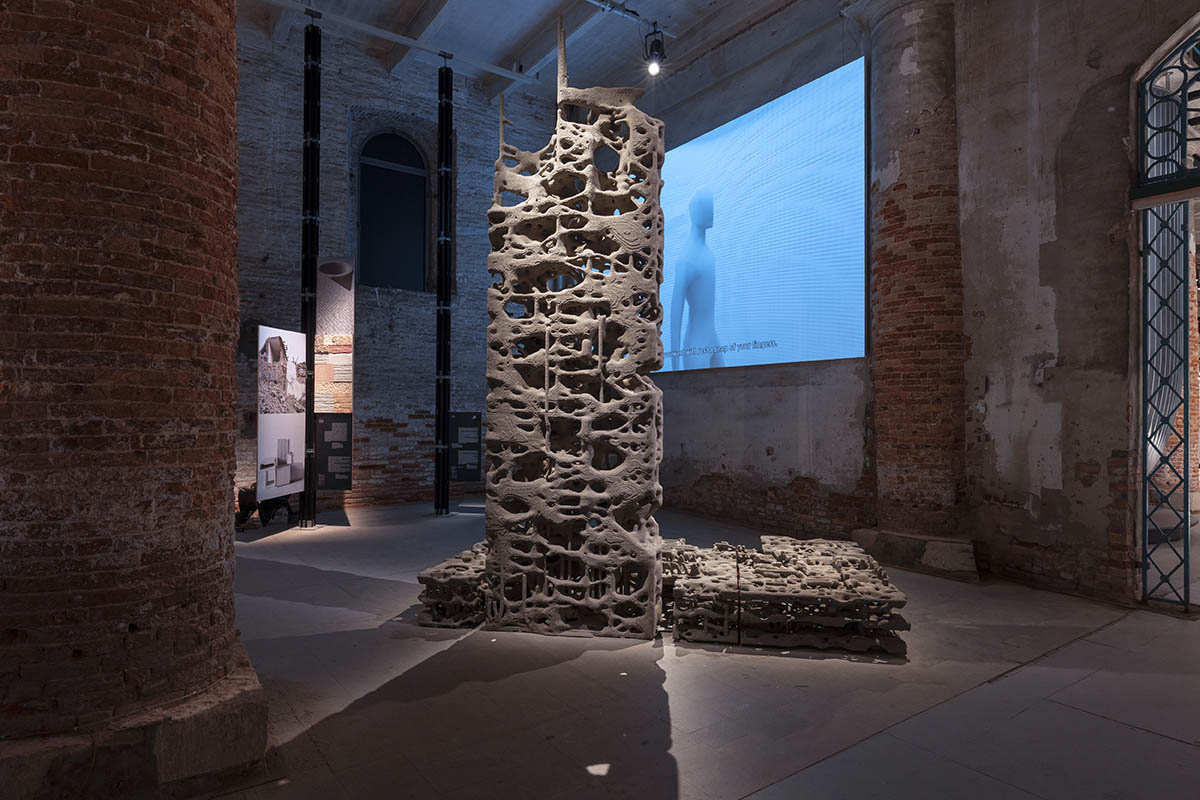WORLDARCHITECTURE.ORG
The Why Factory and Federico Díaz install sponge-like installation, imagining architecture as nature
html PUBLIC "-//W3C//DTD HTML 4.0 Transitional//EN" "http://www.w3.org/TR/REC-html40/loose.dtd"
The Why Factory, a research institute and think tank headed by Winy Maas at the Delft University of Technology, and visual artist Federico Díaz jointly unveiled BIOTOPIA, their contribution to the main exhibition, which was curated by Carlo Ratti and had the theme Intelligens.Natural. Artificial. Collective, at the 19th International Architecture Exhibition of the Venice Architecture Biennale.A radical vision of a living, changing globe and a call to rethink architecture, "BIOTOPIA: Propagative Structures" suggests a future in which biology serves as the basis for everything. Two interconnected components of the presentation—a video that visualizes this future and a sculpture installation that investigates the concept of living matter in constant transformation—bring this vision to life. From May 10 to November 23, 2025, the installation will be on display at the Corderie dell'Arsenale. The team propelled the question of How can we transform our planet into a sustainable home for over 8 billion humans – and countless other species?. Imagine cities turning into woods, buildings sprouting like trees, and streets lighted by bioluminescent lights that are teeming with biodiversity. BIOTOPIA is an invitation to dream and take action. It imagines a world created as nature, not merely with it. The idea of a global sponge—a dynamic bio-matter structure that cools, filters water, produces energy, and harbors life while adapting like a living thing—is at the core of BIOTOPIA. As a result of this bio-matter's growth, shrinkage, and regeneration, biology and technology can be seamlessly and sustainably integrated.The Why Factory produced and Professor Winy Maas directed the movie BIOTOPIA, which envisions a future in which bio-matter turns human communities into self-sustaining systems. It promotes a change from today's design methods, which are mainly non-recyclable, to a future in which architecture is fully integrated, regenerative, and waste-free, much like nature. BIOTOPIA, which challenges conventional ideas of architecture, is based on years of study that was started at The Why Factory (T?F) and developed through design studios at TU Delft and CTU in Prague. It aims to redefine how humans live on Earth by radically integrating biology, technology, and collective intelligence."Today, more than ever, everything is biology. Everything is nature," said Winy Maas. "What can we innovate, technically and spatially? How can natural sciences, automation, nanomaterials, robotics, biotechnology, or biomimicry contribute to establishing new relationships among humans and all other living organisms? Let’s invent and dream. Let’s imagine Biotopia," Maas added.Federico Díaz, a visual artist, created and executed the Propagative Structures project, which gives sculptural form to the concept of living matter in constant change. "We are starting life processes, not designing finished objects," Díaz added. Architecture is examined in "Propagative Structures" as something that, like living things, develops, adapts, and ultimately decays. In this sense, rather than interfering with the planet's metabolic processes, the built environment becomes a collaborator.Building on decades of research into adaptive buildings, biomimicry, and computational design, Díaz's work suggests architecture as an active participant in biological cycles. The installation explores how structures might eventually grow, adapt, and degrade like living things by drawing on the intelligence and resilience of natural systems, such as mangrove root networks. A point in this process is captured by Propagative Structures: a hybrid entity whose form is created by the interaction of data, material, and environment rather than being fixed. It implies that future habitats might develop by gardening rather than building.Image © The Why FactoryImage © The Why FactoryImage © The Why FactoryImage © The Why FactoryImage © The Why FactoryBIOTOPIA: Propagative Structures was made possible by a grant from the Creative Industries Fund NL, which supports projects by Dutch architects, landscape architects, spatial designers, and researchers invited to the 19th International Architecture Exhibition of La Biennale di Venezia, curated by Carlo Ratti.Find out all exhibition news on WAC's Venice Architecture Biennale page. Project factsProject name: BIOTOPIALocation: Corderie dell’Arsenale, Venice, Italy Year: 2025A film: By The Why Factory, Rotterdam, The Netherlands.Team: Winy Maas, Javier Arpa Fernández, Yayun Lui, Thiago Maso, Adrien Ravon,Bryan Lee, Kai Jie Forbes TeeSoundscape: Jaap Berends, Arnhem, The NetherlandsSpecial thanks:Stimuleringsfonds Creatieve Industrie, The NetherlandsFaculty of Architecture and the Built Environment, TU Delft, The Netherlands Faculty of Architecture - Czech Technical University in Prague, Czech Republic IAAC, Institute for Advanced Architecture of Catalonia, Barcelona, Spain MVRDV Next, Rotterdam, The Netherlands.We thank all the students who contributed to the successive Biotopia design studios and research projects.Propagative StructuresArtist: Federico DiazTeam: Jonáš Kolařík, Barbara Holomková, Daniel Marko, Dimitri Nikitin, Petr Pufler, Záviš Unzeitig, Jen Kratochvil.Special thanks: SO ConcreteAll images © Celestia Studio unless otherwise stated.> via The Why Factory
